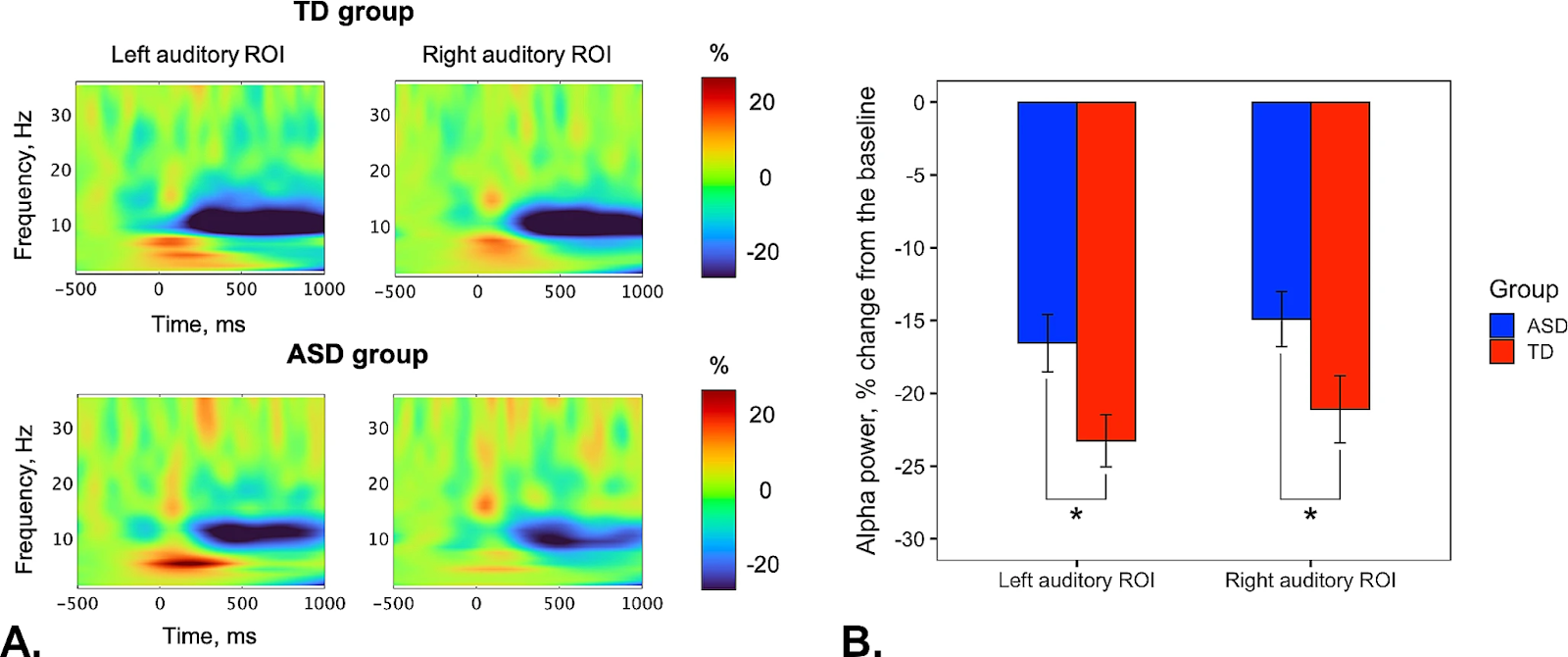Children with Autism Process Auditory Information Differently

A team of scientists, including researchers from the HSE Centre for Language and Brain, examined specific aspects of auditory perception in children with autism. The scientists observed atypical alpha rhythm activity both during sound perception and at rest. This suggests that these children experience abnormalities in the early stages of sound processing in the brain's auditory cortex. Over time, these abnormalities can result in language difficulties. The study findings have been published in Brain Structure and Function.
Autism spectrum disorders (ASD) are a group of conditions caused by abnormalities in brain development that can affect communication skills and social behaviour. Children with ASD often experience co-occurring language impairments, ranging from mild language deficits to a complete inability to speak.
The causes of language impairment in ASD are not yet well understood. Researchers believe that the neurobiological mechanisms of autism stem from an imbalance between excitatory and inhibitory processes in the cerebral cortex, driven by oscillations of nerve cells in the brain. These oscillations produce weak but detectable electromagnetic signals, such as alpha, beta, and gamma rhythms, which can be measured using magnetoencephalography (MEG).
An international team of researchers, including scientists from the HSE Centre for Language and Brain, studied alpha rhythm oscillations (markers of excitability) in children with autism. Alpha rhythms play a key role in processing sensory information and maintaining attention, eg during auditory perception.
The scientists explored the relationship between sound perception and language impairment in children with ASD. To achieve this, they used magnetoencephalography to measure brain activity in 20 children with autism of varying severity and in 20 typically developing controls. All study participants underwent clinical and behavioural language assessments, as well as tests for nonverbal intelligence (IQ) and the severity of autistic traits. Their language skills were measured using RuCLAB (Russian Child Language Assessment Battery). During the MEG, participants were presented with sound stimuli while their brain activity was measured, requiring no special actions from them. The authors of the experiment monitored alpha oscillations both at rest and during the processing of presented audio signals.
It was found that children with autism exhibit impaired alpha rhythms both during auditory perception and at rest. Typically, when sounds are processed in the auditory cortex, the power of alpha waves decreases significantly, while it increases during rest. The opposite pattern was observed in children with autism.

'A slight decrease in alpha rhythm power during auditory information processing in children with autism indicates increased excitability of neural networks in the auditory cortex, confirming an imbalance between excitation and inhibition in the cerebral cortex,' explains Vardan Arutiunian, co-author of the study and research fellow at the Seattle Children's Research Institute, USA.
The authors of the paper also found a link between brain activity at rest in the left auditory cortex and the language abilities of children with ASD. The researchers converted the complex, multidimensional MEG signals into a set of parameters, analysed them, and discovered that one component of the signal (offset), which reflects the average frequency of neural discharges, is associated with language skills. The higher this parameter (and consequently, the greater the resting neural excitability in the left auditory cortex), the poorer the language skills of children with ASD.

Olga Dragoy
'We analysed all the data collected during the experiment, including the MEG results, IQ tests, and assessments of autistic traits and language skills. It was found that children with more impaired neural processes in the left hemisphere exhibited poorer language abilities. We observed that in autism, abnormalities are present at the early stages of information processing in the auditory cortex, which can impact higher-level processes such as language,' according to Olga Dragoy, Director of the HSE Centre for Language and Brain.
The study's findings can lead to a better understanding of the causes of language impairment in autism spectrum disorders and contribute to the development of corrective interventions.
See also:
Similar Comprehension, Different Reading: How Native Language Affects Reading in English as a Second Language
Researchers from the MECO international project, including experts from the HSE Centre for Language and Brain, have developed a tool for analysing data on English text reading by native speakers of more than 19 languages. In a large-scale experiment involving over 1,200 people, researchers recorded participants’ eye movements as they silently read the same English texts and then assessed their level of comprehension. The results showed that even when comprehension levels were the same, the reading process—such as gaze fixations, rereading, and word skipping—varied depending on the reader's native language and their English proficiency. The study has been published in Studies in Second Language Acquisition.
Mortgage and Demography: HSE Scientists Reveal How Mortgage Debt Shapes Family Priorities
Having a mortgage increases the likelihood that a Russian family will plan to have a child within the next three years by 39 percentage points. This is the conclusion of a study by Prof. Elena Vakulenko and doctoral student Rufina Evgrafova from the HSE Faculty of Economic Sciences. The authors emphasise that this effect is most pronounced among women, people under 36, and those without children. The study findings have been published in Voprosy Ekonomiki.
Scientists Discover How Correlated Disorder Boosts Superconductivity
Superconductivity is a unique state of matter in which electric current flows without any energy loss. In materials with defects, it typically emerges at very low temperatures and develops in several stages. An international team of scientists, including physicists from HSE MIEM, has demonstrated that when defects within a material are arranged in a specific pattern rather than randomly, superconductivity can occur at a higher temperature and extend throughout the entire material. This discovery could help develop superconductors that operate without the need for extreme cooling. The study has been published in Physical Review B.
Scientists Develop New Method to Detect Motor Disorders Using 3D Objects
Researchers at HSE University have developed a new methodological approach to studying motor planning and execution. By using 3D-printed objects and an infrared tracking system, they demonstrated that the brain initiates the planning process even before movement begins. This approach may eventually aid in the assessment and treatment of patients with neurodegenerative diseases such as Parkinson’s. The paper has been published in Frontiers in Human Neuroscience.
Civic Identity Helps Russians Maintain Mental Health During Sanctions
Researchers at HSE University have found that identifying with one’s country can support psychological coping during difficult times, particularly when individuals reframe the situation or draw on spiritual and cultural values. Reframing in particular can help alleviate symptoms of depression. The study has been published in Journal of Community Psychology.
Scientists Clarify How the Brain Memorises and Recalls Information
An international team, including scientists from HSE University, has demonstrated for the first time that the anterior and posterior portions of the human hippocampus have distinct roles in associative memory. Using stereo-EEG recordings, the researchers found that the rostral (anterior) portion of the human hippocampus is activated during encoding and object recognition, while the caudal (posterior) portion is involved in associative recall, restoring connections between the object and its context. These findings contribute to our understanding of the structure of human memory and may inform clinical practice. A paper with the study findings has been published in Frontiers in Human Neuroscience.
Researchers Examine Student Care Culture in Small Russian Universities
Researchers from the HSE Institute of Education conducted a sociological study at four small, non-selective universities and revealed, based on 135 interviews, the dual nature of student care at such institutions: a combination of genuine support with continuous supervision, reminiscent of parental care. This study offers the first in-depth look at how formal and informal student care practices are intertwined in the post-Soviet educational context. The study has been published in the British Journal of Sociology of Education.
AI Can Predict Student Academic Performance Based on Social Media Subscriptions
A team of Russian researchers, including scientists from HSE University, used AI to analyse 4,500 students’ subscriptions to VK social media communities. The study found that algorithms can accurately identify both high-performing students and those struggling with their studies. The paper has been published in IEEE Access.
HSE Scientists: Social Cues in News Interfaces Build Online Trust
Researchers from the HSE Laboratory for Cognitive Psychology of Digital Interface Users have discovered how social cues in the design of news websites—such as reader comments, the number of reposts, or the author’s name—can help build user trust. An experiment with 137 volunteers showed that such interface elements make a website appear more trustworthy and persuasive to users, with the strongest cue being links to the media’s social networks. The study's findings have been published in Human-Computer Interaction.
Immune System Error: How Antibodies in Multiple Sclerosis Mistake Their Targets
Researchers at HSE University and the Institute of Bioorganic Chemistry of the Russian Academy of Sciences (IBCh RAS) have studied how the immune system functions in multiple sclerosis (MS), a disease in which the body's own antibodies attack its nerve fibres. By comparing blood samples from MS patients and healthy individuals, scientists have discovered that the immune system in MS patients can mistake viral proteins for those of nerve cells. Several key proteins have also been identified that could serve as new biomarkers for the disease and aid in its diagnosis. The study has been published in Frontiers in Immunology. The research was conducted with support from the Russian Science Foundation.


